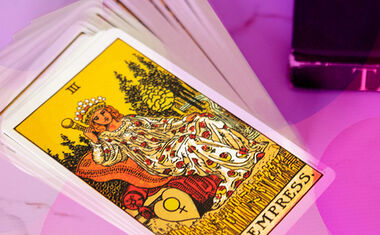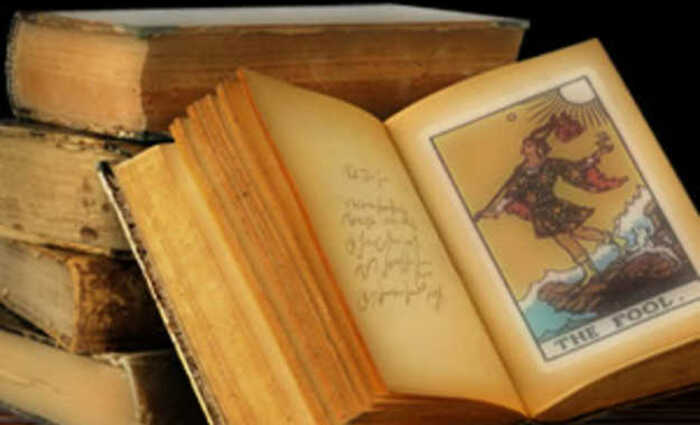
Iconology of the Tower Cards
From the Iconology Section of the Robert O'Neill Library
The early Tarot images
There are five surviving images of the Tower from the 15/16th centuries (Fig. 1). Four of the towers are square with doorways and four show rocks, hail, or masonry falling.
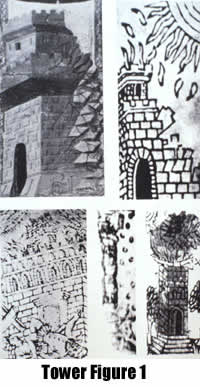 Three show flames coming from the top of the Tower and apparently originating from the Sun in the upper corner. One shows a couple falling and another appears to have an animal partially concealed behind the tower. Images of the Tower similar to those in Fig. 1 occur occasionally in religious art and are common in the Apocalyptic tradition but do not occur in the traditions associated with Petrarch or the Dance of Death.
Three show flames coming from the top of the Tower and apparently originating from the Sun in the upper corner. One shows a couple falling and another appears to have an animal partially concealed behind the tower. Images of the Tower similar to those in Fig. 1 occur occasionally in religious art and are common in the Apocalyptic tradition but do not occur in the traditions associated with Petrarch or the Dance of Death.
Religious art
The image of the burning tower is not common in religious art but some examples can be found. Voelkle and L'Engle (1998, p. 31) show an illustration from a German manuscript ~1360 that depicts Lot fleeing Sodom with burning towers in the background. There is also an example (Fig. 2) from a depiction of Hell in a French psalter of ~1473.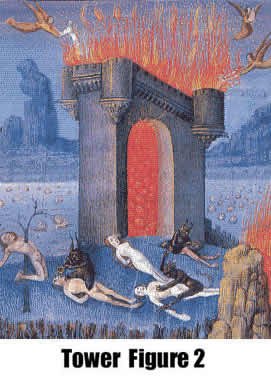
In Fig. 2, notice the square tower with doorway and flames coming from the top. Notice also the association of the Tower (#15) image with the Devil (#14). Although it is a stretch, there is a man impaled on a tree which might be related to the Hangedman (#12) and in the background we see the sea yielding up its dead (Angel #19 and Revelations 20:13). Cavendish (1975, p 122) shows a painting from a psalter of 1424 depicting the building of the tower of Babel. The workmen at the top are arguing and one is shown falling in an inverted position with pieces of masonry. Flint (1991, cover) shows an 11th century illustration of Simon Magus falling headlong from a square tower.
The apocalyptic tradition
The destruction of earthly kingdoms and the fall of Babylon are recurrent themes in Revelations and the artistic renderings of these themes appears to explain the Tarot images. For example, in Revelations 8:7, the first of seven angels blows its trumpet "... and, with that, hail and fire-were dropped on the earth..." and again Revelations 16:20 "...and hail-fell from the sky on the people."
This Apocalyptic reference to hail and fire may explain the falling circles and flames seen on two of the early Tarot (Fig. 1) and are represented in an early 14th century Apocalypse (Deuchler et al. 1971, p. 50), a Flemish manuscript ~1400 (van der Meer 1978, p. 145) and a 13th century Apocalypse (Hassell 1961, plate 6).
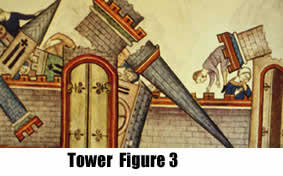 There are two places in Revelations where the fall of Babylon, as a symbol of evil, is celebrated. Revelations 14:8 - "A second angel followed him, calling "Babylon has fallen, Babylon the Great has fallen..." and again Revelations 18:2 - "...Babylon has fallen, Babylon the Great has fallen, and has become the haunt of devils..." The concept of ultimate punishment being dealt to material evil caught the medieval imagination and there are a number of illustrations of these verses that appear to be related to the early Tarot. Figure 3, from a 14th century Apocalypse, shows the collapsing towers, the falling humans, and the doorway as shown on the early Tarot images. Although it is cropped in Fig. 3 to save space, this image shows an angel above holding a scroll that says "Cecidit, cecidit Babylon" (i.e., It has fallen, Babylon has fallen). The complete image can be seen in the Cloisters' Apocalypse (Deuchler et al. 1971, folio 26 verso).
There are two places in Revelations where the fall of Babylon, as a symbol of evil, is celebrated. Revelations 14:8 - "A second angel followed him, calling "Babylon has fallen, Babylon the Great has fallen..." and again Revelations 18:2 - "...Babylon has fallen, Babylon the Great has fallen, and has become the haunt of devils..." The concept of ultimate punishment being dealt to material evil caught the medieval imagination and there are a number of illustrations of these verses that appear to be related to the early Tarot. Figure 3, from a 14th century Apocalypse, shows the collapsing towers, the falling humans, and the doorway as shown on the early Tarot images. Although it is cropped in Fig. 3 to save space, this image shows an angel above holding a scroll that says "Cecidit, cecidit Babylon" (i.e., It has fallen, Babylon has fallen). The complete image can be seen in the Cloisters' Apocalypse (Deuchler et al. 1971, folio 26 verso).
A 14th century Parisian Apocalypse depicts the fall of Babylon (Fig. 4) and an angel ordering the merchants to leave the burning city of Babylon (Revelations 18:4-12, Fig. 5). Figure 4 confirms the association of Devil (#14) and Tower (#15). Figure 5 shows the merchants leaving the burning Babylon with a burning tower and doorway. An earlier manuscript of ~950 shows the destruction of Babylon with burning buildings (Voelkle and L'Engle 1998, p. 79). A Durer woodcut of 1498 (van der Meer 1978, fig. 199) shows towers falling in the background and the harlot of Babylon in the foreground.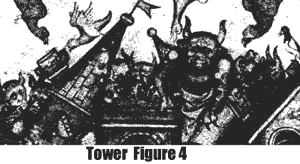
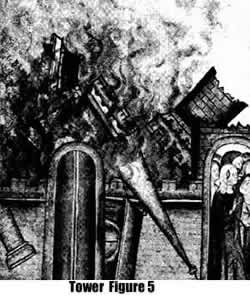 Several other passages in Revelations relate to the destruction of the cities as symbols of material power. For example, Revelations 11:9-13: "Their corpses will lie in the main street of the Great City known by the symbolic names Sodom and Egypt...Immediately there was a violent earthquake, and a tenth of the city collapsed..." and Revelations 16:8 "The fourth angel emptied his bowl over the sun and it was made to scorch people with its flames..." and Revelations 16:18-19 : "...The end has come". Then there were flashes of lightening and peals of thunder and the most violent earthquake" The Great City was split into three parts and the cities of the world collapsed; Babylon the Great was not forgotten: God made her drink the full wine cup of his anger."
Several other passages in Revelations relate to the destruction of the cities as symbols of material power. For example, Revelations 11:9-13: "Their corpses will lie in the main street of the Great City known by the symbolic names Sodom and Egypt...Immediately there was a violent earthquake, and a tenth of the city collapsed..." and Revelations 16:8 "The fourth angel emptied his bowl over the sun and it was made to scorch people with its flames..." and Revelations 16:18-19 : "...The end has come". Then there were flashes of lightening and peals of thunder and the most violent earthquake" The Great City was split into three parts and the cities of the world collapsed; Babylon the Great was not forgotten: God made her drink the full wine cup of his anger."
These passages were illustrated with images such as Fig. 6 (14th century) which shows falling towers, an inverted falling man, and a doorway. A similar image can be found in Deuchler et al. (1971, p 72) and in van der Meer (1978, fig. 151). In Fig. 7 ( 14th century) we see the falling towers, doorway and the Devil (#14). Similar images can be seen in an Anglo-Saxon manuscript ~1255/60 (Grubb 1997, p. 49).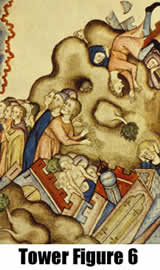
The symbolism of the falling towers and men is quite old in the Apocalyptic tradition as exemplified by a Spanish manuscript of ~ 950 (Fig. 8) that shows the basic theme together with a direct reference to Babylon and illustrates the celestial significance of the event by showing Stars (#16) in the sky overhead. That the Spanish Christians associated Babylon with their Islamic rulers is evident from the shape of the towers in Fig. 8 (Seidel 2000).
Iconological analysis
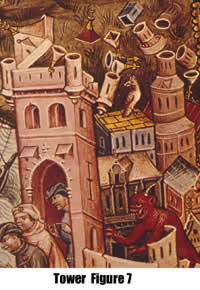 We have mentioned in earlier chapters the iconological association of the Death/Devil/Tower symbols and the Devil/Tower association. For example, Grubb (1997, p. 57) shows a tapestry ~1373-81 that depicts Towers falling and Devils. Figure 9, from a 14th century Apocalypse, shows the Devil (#14)represented as the seven-headed dragon, falling Towers (#15), hailstones as shown on some of early Tarots (Fig. 1) and with Stars (#16) and Sun (#18) in the sky above.
We have mentioned in earlier chapters the iconological association of the Death/Devil/Tower symbols and the Devil/Tower association. For example, Grubb (1997, p. 57) shows a tapestry ~1373-81 that depicts Towers falling and Devils. Figure 9, from a 14th century Apocalypse, shows the Devil (#14)represented as the seven-headed dragon, falling Towers (#15), hailstones as shown on some of early Tarots (Fig. 1) and with Stars (#16) and Sun (#18) in the sky above.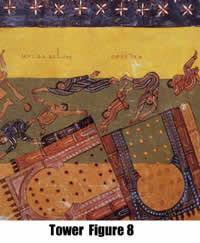
Figure 10 from a 14th century manuscript shows the falling Towers and hail (#15) together with the Moon (#17) and the darkened Sun (#18). A similar image from another 14th century manuscript (Deuchler et al. 1971) shows the falling towers (#15) together with the Stars (#16), Moon (#17) and Sun (#18).
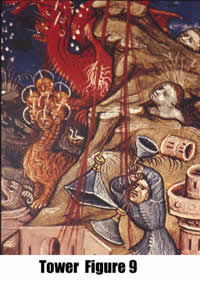 This association of images has two important implications. First, the juxtaposition of images of 13Death/14Devil/15Tower/16Star/17Moon/18Sun seems to confirm the relationship between the sequence of Tarot images in the type B ordering and the Apocalyptic artistic tradition that influenced so much of the religious art of the times. Second, although the juxtaposition of these symbols conveys little significance in the 21st century, it is hard to believe that a 15th century viewer did not saw the apocalyptic implications of this sequence!
This association of images has two important implications. First, the juxtaposition of images of 13Death/14Devil/15Tower/16Star/17Moon/18Sun seems to confirm the relationship between the sequence of Tarot images in the type B ordering and the Apocalyptic artistic tradition that influenced so much of the religious art of the times. Second, although the juxtaposition of these symbols conveys little significance in the 21st century, it is hard to believe that a 15th century viewer did not saw the apocalyptic implications of this sequence!
Interpretation
So how might the 15th century card-players have seen the Tower card? As an urban resident of a city-state in northern Italy, the players would have been intimately aware of the tower as a symbol of power - the ultimate phallic symbol. Perhaps the players would have been proud that the towers of the castles and cathedrals of their city were tall and strong - a sign of their own personal contribution to the city's prestige and prosperity.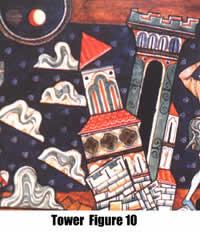
At the same time, the players had been saturated with sermons about the vanities of this world (Rusconi 2000). The players would have heard about the predictions of the Antichrist and the imminent apocalypse. Even if they might not recognize the name of Joachim of Fiore, still the friars led them to expect the overturn of the current regimes, both laic and ecclesiastical (McGinn 2000a).
I can also imagine a group of card-players assembling at the local tavern after a 12 or 16 hour shift. They might be proud of their city, but the gross injustices of their society must also have eaten at them. It was their shoulders and spines and knees that were sacrificed to build those towers. Surely, someone at the table would have snickered knowingly when the Tower card appeared. The concept of an imminent apocalypse had always flourished in societies as an antidote to frustration: "Just you wait!"
So perhaps the sequence of the Devil and the falling Tower would have elicited a gut response in the 15th century card-players? Perhaps we should not be surprised that the Tower card appears in only one of the decks painted for the aristocracy? Perhaps the nobles, subjected to the same fiery Franciscan sermons, were a bit nervous about the implications of the crumbling tower of power?



